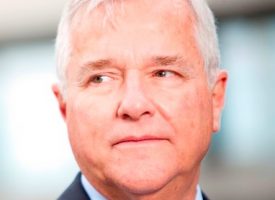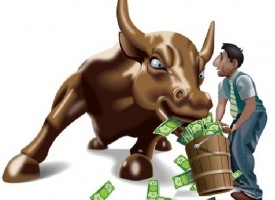Here is why we are going to see a wild week of trading for major markets.
But first, a quick note from Art Cashin…
From Art Cashin: Yet One More Caveat From Jason – The incomparable Jason Goepfert of SentimenTrader noticed the near frothy enthusiasm that followed the IPO in SNAP. He dug into his enormous files to see if prior “hot” IPO’s corresponded to subsequent moves in the general market.
Here’s a bit of what he wrote:
“Investors were hungry for fresh blood. The IPO of Snap on Thursday was well-received. The offer of more than $3 billion not only saw a nice bump at the open but managed to bring in retail traders during the day and end higher than its opening price. There have been three other time periods in the past 20 years when an IPO of more than $1 billion gained at least 30% after rallying during the trading day, which were prior to the market peaks in 2000, 2007, and 2015.”
Now, for a summary of where things stand…
Summary from Peter Boockvar:
Positives:
1) The Fed has finally come around to the belief that rising inflation, a even tighter labor market, a dramatic easing in financial conditions as seen in equity and credit markets, and upcoming fiscal stimulus of some kind would thus mark a good time to raise rates from just .625% sooner rather than later.
2) Initial jobless claims plunged by 19k w/o/w to 223k, well below the estimate of 245k. There was likely seasonally adjustment issues around President’s Day holiday so wait a week to see the real trend. This brings the 4 week average down to 234k from 241k. Continuing claims, delayed by a week, rose by 3k.
3) The ISM manufacturing index for February was 57.7, up 1.7 pt from January and 1.5 pts above the estimate. It’s at the best level since August 2014. Of the 18 industries surveyed, 17 saw improvement vs just 12 last month. The ISM said “Comments from the panel largely indicate strong sales and demand, and reflect a positive view of business conditions with a watchful eye on commodities and the potential for inflation.”
4) The February ISM services index rose 1.1 pts to 57.6, unchanged was expected. It’s at the best level since October 2015. The breadth of the improvement was also evident as 16 of the 18 industries surveyed saw growth vs 12 last month. The two seeing contractions was real estate/rental, leasing (higher rates, less access to capital in CRE, tighter lending standards, lack of inventory?); and information. ISM said “The non manufacturing sector reflected strong growth in February after cooling off in January. Respondents’ comments continue to be mixed, with some uncertainty; however, the majority indicate a positive outlook on business conditions and the overall economy.”
5) With last week’s drop in mortgage rates (before the jump back this week), mortgage applications to buy a home jumped by 6.5% off the lowest level since November but it’s still down by 4.6% y/o/y. Refi’s rose by 5.1% but they are down 45% y/o/y. Mortgage rates are up about 50 bps y/o/y.
6) The Conference Board’s consumer confidence index in February rose 3.2 pts to 114.8 which was above the forecast of 111. It exceeds the December print of 113.3 and is at the best level since July 2001. Both main components were up. The answers to the labor market questions were mixed. Spending intentions in the coming 6 months on auto’s, homes and major appliances are all at pre election levels and thus how one feels doesn’t always equate to how they behave. One year inflation expectations held at 4.9%, a 5 month high.
7) January headline CPI in Japan rose .4% y/o/y as expected vs .3% in December and the core/core rate (ex both food and energy) was up by .2%, twice the pace as in the month prior and also as forecasted. The more up to date February CPI for Tokyo saw no change in prices y/o/y ex food and energy and a drop of .3% at the headline level. Ironically, Japan has actually had price stability over the past 25 years with CPI since 1992 averaging .2% per year.
8) The Japanese jobs market remains tight. The jobs to applicant ratio held at 1.43, the highest since 1991 and the unemployment rate is at just 3%, down one tenth and matching the lowest level since 1995.
9) The China manufacturing data improved slightly in February m/o/m for both the state and private sector weighted measures.
10) India’s services PMI is back above 50 at 50.7 from 49.4 last month as hopefully they are at the end of the disastrous currency swap. Their manufacturing PMI was also up. PMI’s in Malaysia, Vietnam and the Philippines also saw gains.
11) South Korea’s industrial production in January rose 3.3% m/o/m vs the estimate of up .3% and led by semi’s. Exports spiked 20.2% y/o/y, well more than the estimate of up 13.6% with semi’s and petro products the main drivers.
12) The final look at Eurozone services PMI was 55.5, .1 pt below the 1st print but up from 53.7 in January and it’s at the best level since May 2011.
13) The final read of Europe’s February manufacturing PMI was 55.4, up from 55.2 in January and a hair below the initial print of 55.5. It’s still the best level in almost 6 years. Markit said “Companies are reporting stronger demand in both home and export markets, with the weakened euro providing an accompanying tailwind to help drive sales.” Also, “the rate of job creation seen so far this year in the manufacturing sector has consequently been among the best seen in the history of the euro.”
14) The February Economic Confidence index for Europe was 108, essentially flat with 107.9 in January and about in line with the estimate of 108.1. This is though the best level in 6 years but is still below where it was in the peak in 2007.
15) The Eurozone January unemployment rate held at 9.6% as expected, the lowest in almost 8 years. On a Eurozone harmonized measure, the German unemployment rate fell to just 3.8% while France held at 10% and Italy did at 11.9%. The Spanish rate fell two tenths to 18.2%.
16) The number of Germans that were unemployed in February fell by 14k, a bit more than the estimate of a drop of 10k. The unemployment rate held at 5.9%, the lowest since reunification. The labor agency said simply, “The development on the labor market continues to be positive.”
17) The ECB said that loan growth to households in January improved by 2.2% y/o/y, a slight uptick from the 2% rise seen in December. Loan growth to companies was up by 2.3% y/o/y, the same pace of gain seen in the month prior. Money supply growth as measured by M3 was up by 4.9%…
IMPORTANT…
To find out which company is set to become one of the
highest grade producing gold mines on the planet
CLICK HERE OR BELOW:
Negatives:
1) I have a bridge to sell you if you think 3-4 rate hikes this year and next in addition to a shrinking of the Fed balance sheet maybe beginning late this year won’t matter to the economy and asset prices no matter the fiscal reform that is eventually passed.
2) Even with record incentives, February auto sales at 17.47mm SAAR were no different than January, down from a year ago and below the estimate of 17.7mm.
3) After upside seen in December (and revised up by 4 tenths to up 1.1%), January non defense durable goods orders ex aircraft disappointed with a .4% m/o/m drop, below the estimate of up .5% (from the pre revised December figure). Core capital spending in January was up 2.6% y/o/y which remains in the punk range we’ve seen in this expansion. On an absolute dollar level, spending in January 2017 was no different than what was seen in August 2000.
4) Notwithstanding the robust economic and consumer sentiment figures seen, Q1 GDP is estimated to have a one handle. The Atlanta Fed in particular cut its estimate to 1.8% from 2.5%. Hopefully Q2 is when we start to see results from the economic optimism.
5) The January PCE inflation deflator rose by .4% m/o/m and 1.9% y/o/y at the headline level, both one tenth less than expected but the core rate up .3% m/o/m and 1.7% y/o/y was right in line. That headline number matches the highest since April 2012 and has basically doubled from last summer mostly due to energy prices. The core rate y/o/y rise holds at the quickest pace since July 2014.
6) Personal spending was up by .2% (nominal rate), one tenth less than expected and which means REAL spending was negative in January by .3% (rounded). The nominal income gain of .4% m/o/m was also fully offset by the rise in inflation. The savings rate was 5.5% vs 5.4% in December but down from 5.7%+ in the prior 18 months. Jay Leno once said “Congress wants to replace the dollar bill with a coin. They’ve already done it: It’s called a nickel.”
7) Pending home sales in January fell 2.8% m/o/m, well worse than the estimate of up .6%. Also, it was from a lower than expected base as December was revised down by 8 tenths. This takes the seasonally adjusted level of contract signings to the lowest since January 2016. The NAR said “The significant shortage of listings last month along with deteriorating affordability as the result of higher home prices and mortgage rates kept many would be buyers at bay.”
8) While old news since we’re 2/3 of the way thru Q1, US Q4 GDP was left unrevised at 1.9% vs the expectation that it was going to be shifted to 2.1%. GDP growth averaged 1.9% in 2016.
9) The goods trade balance was $3.2b more than expected and wholesale inventories fell .1% m/o/m instead of rising by .4% as forecasted in January. There was a sharp 2.3% m/o/m increase in motor vehicle/parts inventory at the dealer level and is up by 9.4% y/o/y.
10) Japanese consumer confidence for February was 43.1, essentially unchanged for the 2nd month with the key Income Growth component lower. Since Abenomics began in late 2012, this confidence index is up a whopping 3 pts. It touched 50 in 2006. A lot of trees were cut down to print all that yen in order to get that kind of lame progress. Overall household spending in January fell 1.2% y/o/y, 3 times worse than expected and negative for the 11th month in a row.
11) Japan’s services PMI in February fell to 51.3 from 51.9. Their manufacturing index was revised slightly lower but is still at the best level since March 2014. PMI’s also fell in Hong Kong and Singapore. February manufacturing PMI in South Korea is still below 50 at 49.2 from 49 in January. Manufacturing PMI’s in Indonesia and Taiwan both dropped m/o/m.
12) Japanese industrial production in January fell .8% m/o/m which was a miss relative the estimate of a gain of .4%. The y/o/y gain was still a pretty good 3.2%.
13) The private sector weighted Chinese services index fell m/o/m by .5 pt to 52.6. That quietly is at a 4 month low. The state sector weighted service index fell too.
14) Hong Kong exports fell 1.2% y/o/y, well worse than the estimate of up 7.8%. Imports were also soft, falling by 2.7% y/o/y instead of rising by 8.6% as expected. A government spokesman said “the trading environment is still subject to considerable uncertainties arising from the future US trade policy direction, US interest rate normalization and unfolding of Brexit. Fragile fundamentals of some major advanced economies and heighted geopolitical tensions in various regions are also sources of concern.”
15) The UK services PMI fell to 53.3 from 54.5. The estimate was 54.1 and its at a 5 month low. New orders fall but optimism remains high. “Input cost inflation reaches an 8 ½ year high” and “weaker consumer spending was a key cause of slower service sector growth, suggesting that household budgets are starting to crack under the strain of higher prices and weak wage growth.” And central banks want higher inflation?
16) The manufacturing PMI index in the UK fell to 54.6 from 55.7. The estimate was for a slight rise to 55.8 and its now at a 3 month low but still at a good level. Prices pressures eased from January “but remained among the fastest seen during the survey history.”
17) Retail sales in the euro area in January disappointed with a .1% m/o/m decline vs the estimate of up .3% and December was revised down by two tenths. It’s 4 of the last 5 months of m/o/m sales declines although are still up y/o/y. German retail sales in particular were softer than expected. Is this all the result of higher inflation? Higher energy costs? Most likely it was a factor.
18) Eurozone CPI in February printed exactly 2% y/o/y, up from 1.8% in January and in line with the forecast. One year ago headline CPI was -.2%. The core rate rose .9% y/o/y for the 3rd month in a row as expected. Services inflation remains very steady with its 1.3% gain, matching the quickest pace since March 2016. It was the goods side that kept a lid on the core rate as non energy industrial goods prices were up just .2% y/o/y.
19) German CPI in February rose 2.2% y/o/y, one tenth more than expected, up from 1.9% in January, just .7% in November and zero back in May. The pace matches the quickest since May 2012. German January import prices rose .9% m/o/m and 6% y/o/y (highest since May 2011). Yes, petro had a big impact but ex petro prices, import prices were still up 3% y/o/y.
***KWN has just released the powerful audio interview with Rick Rule CLICK HERE OR ON THE IMAGE BELOW.
***ALSO JUST RELEASED: Greyerz – Global Panic Is Now Only Days Away CLICK HERE.
***KWN has released the remarkable audio interview with former U.S. Treasury official Dr. Paul Craig Roberts CLICK HERE OR ON THE IMAGE BELOW.
© 2017 by King World News®. All Rights Reserved. This material may not be published, broadcast, rewritten, or redistributed. However, linking directly to the articles is permitted and encouraged.










